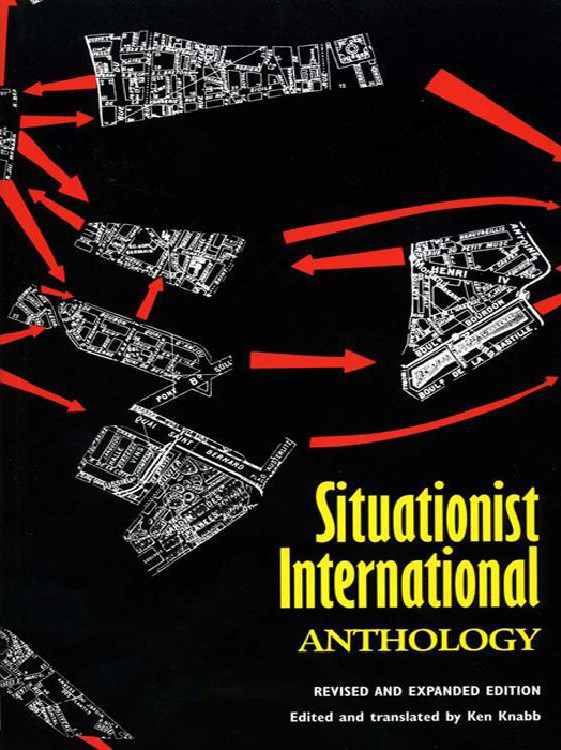Ken Knabb (ed.): Situationist International Anthology (1981/2006)
Filed under book | Tags: · art, avant-garde, capitalism, consumerism, everyday, life, mass media, politics, psychogeography, situationists, spectacle, theory

“In 1957 a few experimental European groups stemming from the radical tradition of dadaism and surrealism, but seeking to avoid the cooption to which those movements succumbed, came together to form the Situationist International. The name came from their aim of liberating everyday life through the creation of open-ended, participatory “situations” (as opposed to fixed works of art) — an aim which naturally ran up against the whole range of material and mental obstacles produced by the present social order. Over the next decade the situationists developed an increasingly incisive critique of the global ‘spectacle-commodity system’ and of its bureaucratic leftist pseudo-opposition, and their new methods of agitation helped trigger the May 1968 revolt in France. Since then — although the SI itself was dissolved in 1972 — situationist theories and tactics have continued to inspire radical currents in dozens of countries all over the world.
The SI Anthology, generally recognized as the most comprehensive and accurately translated collection of situationist writings in English, presents a chronological survey of the group’s activities and development as reflected in articles from its French journal and in a variety of leaflets, pamphlets, filmscripts and internal documents, ranging from their early experiments in urban “psychogeography” and cultural subversion to their lucid analyses of the Watts riot, the Vietnam war, the Prague Spring, the Chinese “Cultural Revolution” and other crises and upheavals of the sixties.
A greatly revised, and expanded edition, with over 100 pages of new material.”
First published in 1981
Translated by Ken Knabb
Publisher Bureau of Public Secrets, Berkeley, CA, 2006
No copyright. Any of the texts in this book may be freely reproduced, translated or adapted, even without mentioning the source.
ISBN 0939682044, 9780939682041
532 pages
via quackalist
Reviews: Libero Andreotti (J Architectural Education, 1996), Not Bored! (2007).
HTML (from the publisher)
PDF (7 MB, added on 2019-11-13)
EPUB (updated on 2019-11-13)
Arndt Niebisch: Media Parasites in the Early Avant-Garde: On the Abuse of Technology and Communication (2012)
Filed under book | Tags: · art history, avant-garde, dada, futurism, mass media, media ecology, networks, noise, parasite, performance, poetry, radio, sound, subversion, technology

“The avant-garde movements of the early twentieth century inhabited the media discourses of their time like parasites, constantly irritating and taking from them. Dadaists ripped images of a mechanically reproduced world out of newspapers and magazines and reassembled them in their collages. Futurists instrumentalized the brevity of telegraph messages for their free word poetics. Artists such as F.T. Marinetti, Raoul Hausmann and Luigi Russolo constantly abused existing media technologies and hijacked public communication. This study traces these subversive tactics from avant-garde poetry to media technological experiments with radio tubes.”
Publisher Palgrave Macmillan, 2012
Avant-Gardes in Performance series
ISBN 1137276851, 9781137276858
250 pages
PDF, PDF (updated on 2016-3-15)
Comments (3)Leshu Torchin: Creating the Witness: Documenting Genocide on Film, Video, and the Internet (2012)
Filed under book | Tags: · documentary film, documentary photography, film, genocide, holocaust, human rights, internet, mass media, photography, politics, television, video

“Since the beginning of the conflict in 2003, more than 300,000 lives have been lost in Darfur. Players of the video game Darfur Is Dying learn this sobering fact and more as they endeavor to ensure the survival of a virtual refugee camp. The video game not only puts players in the position of a struggling refugee, it shows them how they can take action in the real world.
Creating the Witness examines the role of film and the Internet in creating virtual witnesses to genocide over the past one hundred years. The book asks, how do visual media work to produce witnesses—audiences who are drawn into action? The argument is a detailed critique of the notion that there is a seamless trajectory from observing an atrocity to acting in order to intervene. According to Leshu Torchin, it is not enough to have a camera; images of genocide require an ideological framework to reinforce the messages the images are meant to convey. Torchin presents wide-ranging examples of witnessing and genocide, including the Armenian genocide, the Holocaust (engaging film as witness in the context of the Nuremburg trials), and the international human rights organization WITNESS and its sustained efforts to use video to publicize human rights advocacy and compel action.
From a historical and comparative approach, Torchin’s broad survey of media and the social practices around it investigates the development of popular understandings of genocide to achieve recognition and response—both political and judicial—ultimately calling on viewers to act on behalf of human rights.”
Publisher University of Minnesota Press, 2012
Visible Evidence series, Volume 26
ISBN 0816676224, 9780816676224
296 pages
Author’s discussion of the book
Publisher
PDF (updated on 2021-1-24)
Comments (3)
